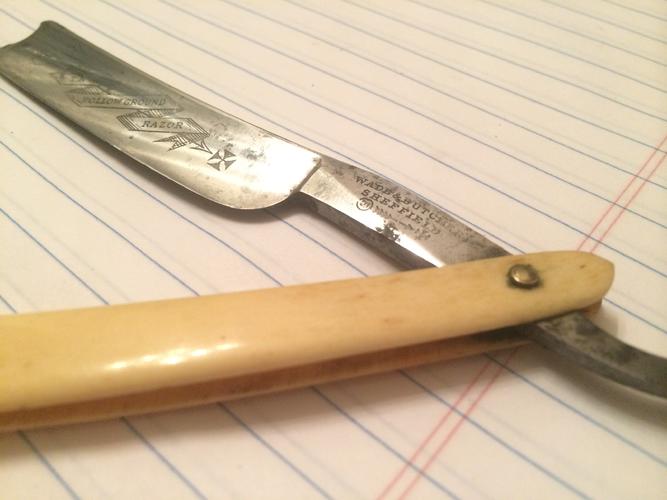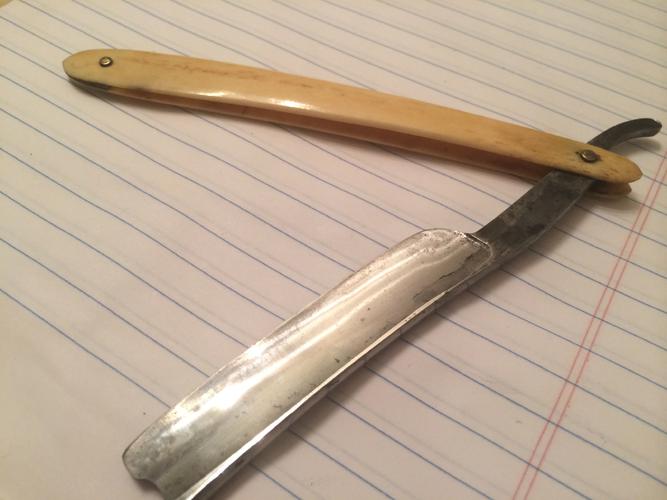Results 21 to 30 of 32
Thread: wade and butcher question..
-
09-07-2014, 11:19 PM #21

Looking at it more closely, I wonder if the scales might be ivory ? I don't think they are celluloid because of the pins not having collars. Anyway, I would clean the scales with soap and water, a soft toothbrush. Flatten the ends of a Q-tip to get inside the scales. If you're really troubled by grunge at the pivot, dental floss. I would polish the blade with a paper towel and some flitz, maas, semichrome, or something like that. That is all I would do. Of course some guys would send it out to have it unpinned, polished up and all of that but that ain't my thing. I like some of the battle scars 100+ year old razors acquire.Be careful how you treat people on your way up, you may meet them again on your way back down.
-
09-07-2014, 11:28 PM #22Senior Member


- Join Date
- Jan 2011
- Location
- Roseville,Kali
- Posts
- 10,432
Thanked: 2027
Would be nice to see all cleaned as Jimmy says,I think I see collors,hard to tell tho.
CAUTION
Dangerous within 1 Mile
-
09-08-2014, 12:13 AM #23
-
09-08-2014, 02:07 AM #24Senior Member


- Join Date
- Jan 2011
- Location
- Roseville,Kali
- Posts
- 10,432
Thanked: 2027
Scales look like bone perhaps.
CAUTION
Dangerous within 1 Mile
-
09-08-2014, 04:11 PM #25Senior Member

- Join Date
- Dec 2013
- Posts
- 114
Thanked: 9
-
09-11-2014, 12:44 AM #26
-
09-11-2014, 01:03 AM #27

Scales on the first one are likely vulcanite, not a chance of being tortoise. Not sure where the idea that tortoise severely darkens over time comes from, there's tortoise from the 1700s that's bright as day, maybe it comes from some razors that were made with the darker areas of tortoise to begin with? I have some old French ones that just were never made with scutes that had nice light areas. Also, my bet would be that those scales are not original. Remember, just because you got it like it is or even that it's been in a family for 150 years doesn't mean the scales are original to the razor, this can make dating problematic sometimes. The WB logo looks like it is etched, this would back up the later date of the razor; going by the shape of it will be difficult as this razor has seen very very heavy regrinding / reprofiling.
Scales on razor #2 are definitely bone. You can tell from all the black streaks and specs coming from the pores in the bone. Further, not as strong evidence, but there are collars; ivory was typically peened collarless.
-
09-11-2014, 01:25 AM #28

[QUOTE=ScienceGuy;1391977]Scales on the first one are likely vulcanite, not a chance of being tortoise. Not sure where the idea that tortoise severely darkens over time comes from, there's tortoise from the 1700s that's bright as day, maybe it comes from some razors that were made with the darker areas of tortoise to begin with? I have some old French ones that just were never made with scutes that had nice light areas. Also, my bet would be that those scales are not original. Remember, just because you got it like it is or even that it's been in a family for 150 years doesn't mean the scales are original to the razor, this can make dating problematic sometimes. The WB logo looks like it is etched, this would back up the later date of the razor; going by the shape of it will be difficult as this razor has seen very very heavy regrinding / reprofiling.
Scales on razor #2 are definitely bone. You can tell from all the black streaks and specs coming from the pores in the bone. Further, not as strong evidence, but there are collars; ivory was typically peened collarless.[/QUOTE
Thanks for the update on razor 2 - it's kinda hard to get good info on blades - when all people wanna do is buy them, restore them and or charge you for any of the following. Is their a guide or any good books on dating/collecting for razors I should be looking for/ or saving for that matter?www.rzrrestoration.com
Interested in Japanese Blades & Wade&Butcher razors
-
09-11-2014, 01:46 AM #29

Some of it comes from experience, i.e. getting to know shapes, styles, grinds, etc, but that is very rough dating. Symbols can be helpful, like VR, WR GR etc for the different royal periods. Mainly it comes down to knowledge of the maker (and how to search the directories), to see when they existed or when they might have changed their markings. When you put all of that together, you get a decent idea of a date. Sometimes though, you're lucky to get +/- 10 years.
-
09-11-2014, 01:03 PM #30Senior Member

- Join Date
- Dec 2013
- Posts
- 114
Thanked: 9


 2Likes
2Likes LinkBack URL
LinkBack URL About LinkBacks
About LinkBacks









 Reply With Quote
Reply With Quote



